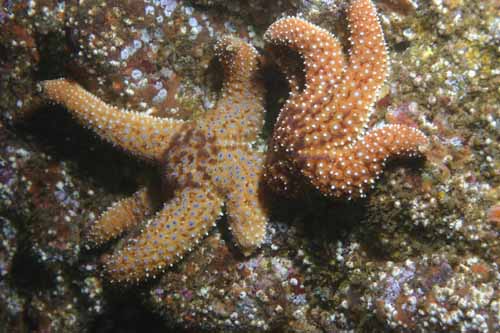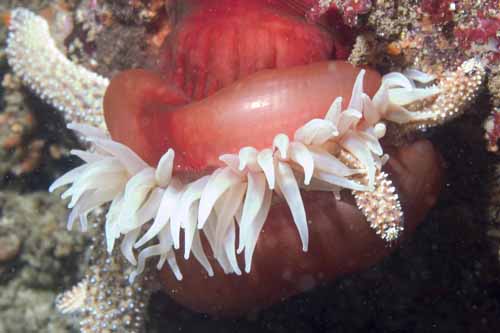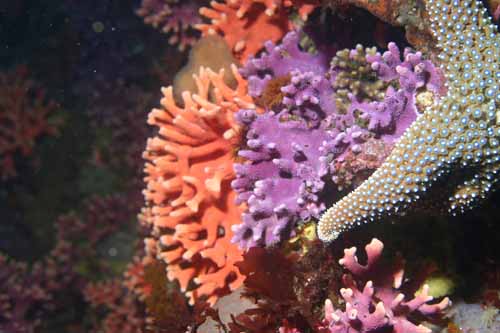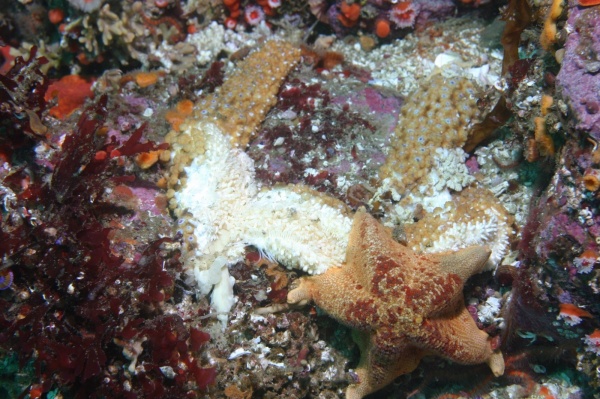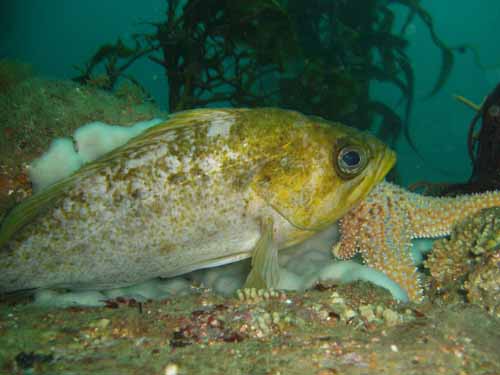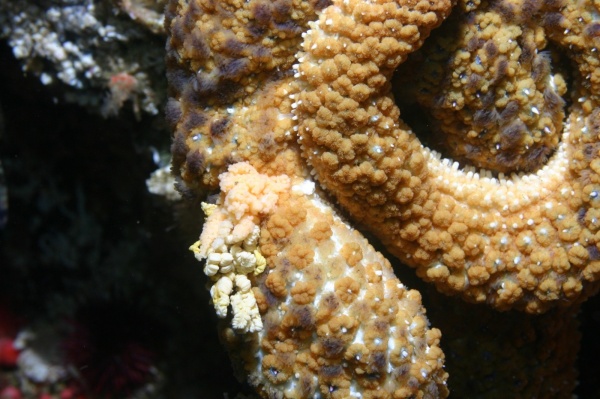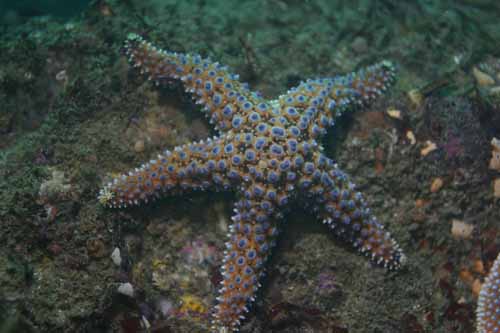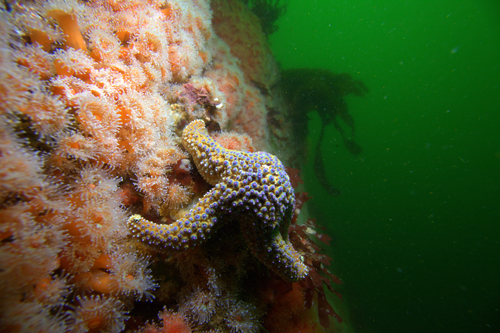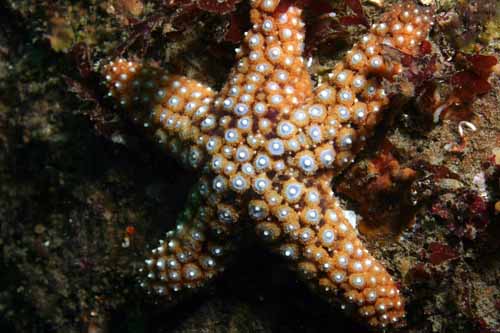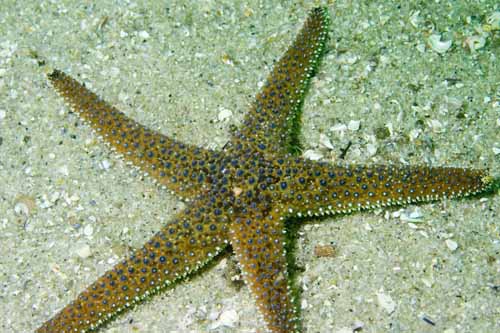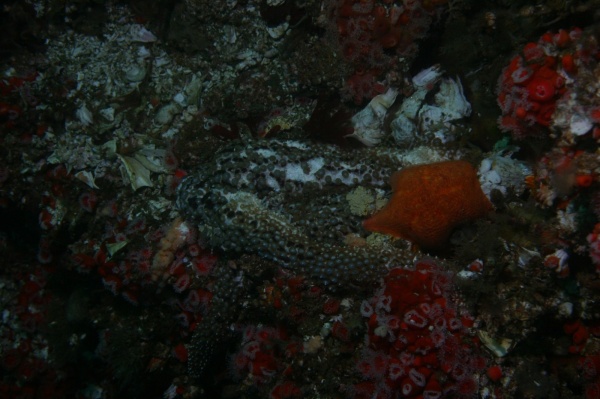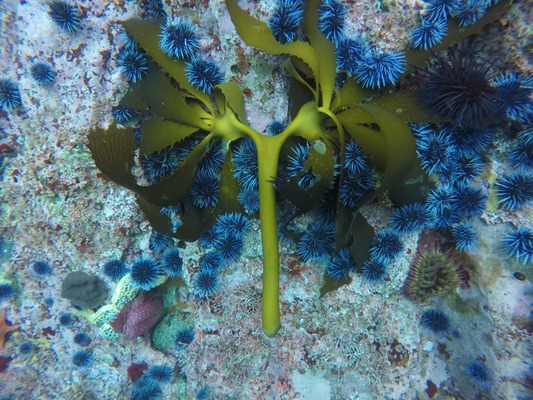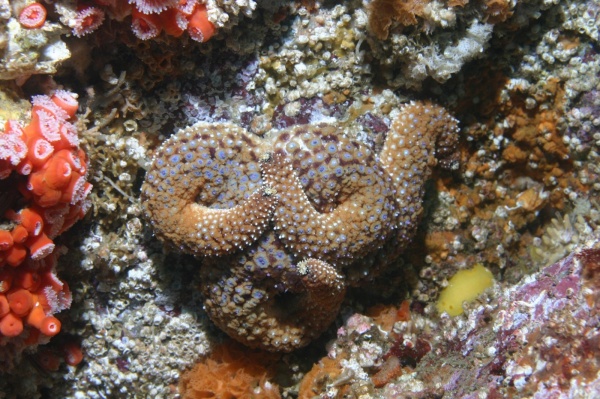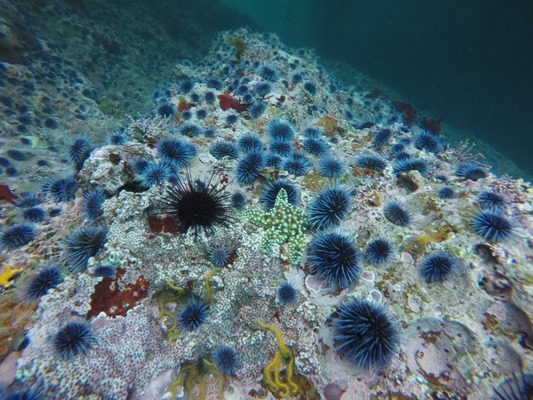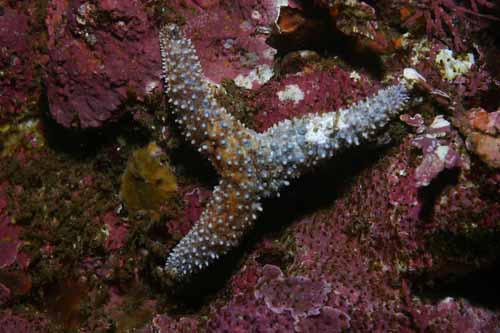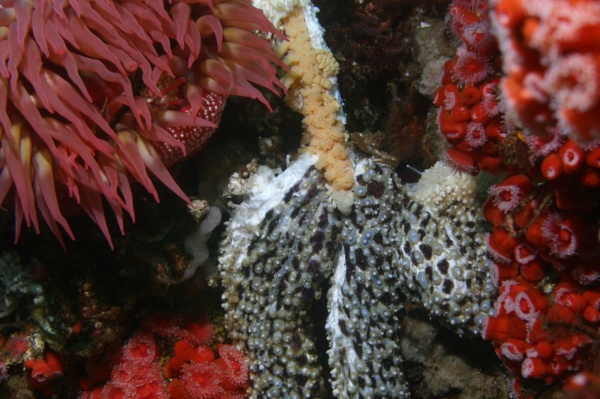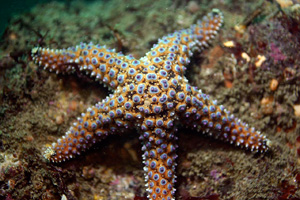
Giant-spined star
Pisaster giganteus
Overview
Key Features:
Large white spines surrounded by blue or purple rings, with a body color that is light brown or blue.Similar Species:
Short-spined star (Pisaster brevispinus)Ochre star (Pisaster ochraceus)
False Ochre Star (Evasterias troschelii)
Primary Common Name:
Giant-spined starGeneral Grouping:
Sea stars, urchins, cucumbers, sand dollars, brittle starsGeographic Range:
Vancouver Island, British Columbia to Isla Cedros, Baja California
Pisaster giganteus can be found from Vancouver Island, British Columbia to Isla Cedros, Baja California.Intertidal Height:
-2 to 0 feet (-0.6096 to 0 meters)Notes:
Pisaster giganteusoccupies the lower intertidal but is rarely found at most sites.Subtidal Depth Range:
Minimum Depth: 0 meters or 0 feetMaximum Depth: 90 meters or 299.7 feet
Notes:
Pisaster giganteus lives subtidally down to 90 m.Habitats:
bay (rocky shore), bay (sandy shore), exposed rocky shore, kelp forest, protected rocky shoreNotes:
Pisaster giganteus lives on rocky bottoms and occasionally on sand bottoms and pier pilings from the very low intertidal to about 90 m in depth.Abundance:
Relative Abundance:
Pisaster giganteus is a common sea star in the subtidal on rocky habitats.Species Description:
General:
Pisaster giganteus belongs to the Family Asterinidae in the Class Stelleroidea in the Phylum Echinodermata. This phylum includes all feather stars, sea stars, sea urchins, sea cucumbers and brittle stars. The literal translation of echinoderm is spiny skinned referring to the unique construction of their endoskeleton which is composed of large numbers of calcium carbonate crystals imbedded in the tissues. Despite Pisaster giganteus's common name, Giant Sea Star or Giant Spined Star, it is by no means gigantic, though it does have distinctive large spines. The average intertidal Pisaster giganteus is smaller than the average Ochre Sea Star, Pisaster ochraceus. However, individuals living in the subtidal may greatly exceed Pisaster ochraceus in size.Distinctive Features:
Pisaster giganteus is a heavy sea star with a tough, firm body and thick arms. Its spines are large and long with swollen tips and are uniformly spaced. The body is light brown, tan or purple with blue rings surrounding the base of the spines.Size:
Pisaster giganteus can grow to a diameter of about 60 cm, with subtidal specimens being much larger than intertidal individuals.Natural History:
General:
Pisaster giganteus, along with all echinoderms, possesses a water vascular system, which is comprised of water-filled tubes. This system is used for respiration, to capture food and also forms the basis of their tube feet which allow them to move about and cling to substrate. Pisaster giganteus has a nervous system, but lacks advanced sensory organs such as eyes. They do, however, have a complex digestive system. Pisaster giganteus also has the ability to regenerate, if it looses all but one of its legs, it can regenerate them after time. Even if this sea star is cut in half, each half can grow a new half.Pisaster giganteus faces many natural challenges including extreme temperature changes, wind conditions and tides, all of which can effect their population. Humans have also stressed sea star population due to the disturbance caused by tourists, divers and students collecting organisms. Collecting is now prohibited except for research purposes. Pisaster giganteus also faces the challenge of catching prey, which can be especially trying since many species exhibit an avoidance response when in the vicinity of this sea star. Abalone, limpets and turban snails have all been shown to move away when they are touched by a sea star, and some can even detect the sea star by scent. Pisaster giganteus often has to select prey that may be less desirable, but more catchable.
Predator(s):
Sea gulls and Sea Otters, Enhydra lutris, are the major predators on Pisaster giganteus. Also, various snails and nudibranchs are known to feed on Pisaster giganteus larvae.Prey:
Pisaster giganteus eats a variety of organisms including snails, chitons, vermetid gastropods, barnacles, limpets, and bivalves, such as the California Mussel, Mytilus californicus.Feeding Behavior:
Carnivore, ScavengerNotes:
Pisaster giganteus is an active predator with a broad diet that likely depends on which prey are present and on the defensive ability of the intended prey. It eats by extending its stomach, as all sea stars do, and can even fit its stomach into tiny gaps, such as at the hinge of a mussel shell. Interestingly in the lab, Pisaster giganteus can been trained to associate light stimulus with food.Seasonal Behavior
March - April
Reproduction:
Pisaster giganteus has separate sexes and fertilization takes place in the water column after spawning where sperm and eggs are released. Their gonads are enlarged in the winter and spawning occurs between March and April. Interestingly, the sea star larvae start life in a bilaterally symmetrical form and in adulthood attains radial symmetry.References
- Gotshall, D. 2005. Guide to marine invertebrates : Alaska to Baja California. Sea Challengers, Monterey, CA. 117 p.
- Meinkoth, N.A. 1998. National Audubon Society Field Guide to North American Seashore Creatures. A.A. Knopf, New York, NY. 813 p.
- Murray, S. 1997. Field Marine Biology. World Wide Web electronic publication. http://biology.fullerton.edu/courses/biol_317/web/Murray/Fall97/, Accessed [09/14/06].
- Ricketts, E. F., J. Calvin, and J.W. Hedgpeth. 1985. Between Pacific tides. Stanford University Press, Stanford, CA. 652 p.
Related Information
Photo Library
Click on an image below to view a larger version in the SIMoN Photo Library. You will also be able to view important information on each photo such as photographer, date, caption and more
